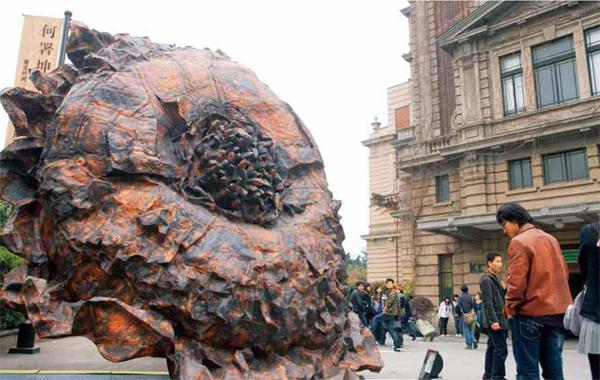从野火到葵颂,书写时代描绘生命
林梢青?付玉婷
许江,中国美术学院院长,著名画家,生于1955年。
如果要看他的改革开放40年,女儿许嘉的视角或是一种。她曾在《我的父亲许江》中写道:“父亲至今不会用电脑也不会发微信,是这个时代坚持用笔记录思考的写作者。”
这平淡的描述中,是对那一代人深深的理解与敬意——在这个时代,变是容易的,不变却很难。
如果需要用一样东西来形容此刻的许江,没有什么比他画笔下的“葵”更合适的了。
前不久,“葵颂——许江近作展”作为改革开放40周年纪念展登陆上海民生现代美术馆。很多人都在问,这一次,你的葵有什么不一样?其实,许江与葵,始终如一。
艺术家邱志杰有一段回忆,那是2003年8月的一天,他们在土耳其马尔马拉海附近的小亚细亚高原上。一瞬间,他看到了夕阳下那片广袤的葵园,钢浇铁铸一般与大地浑然一体,“就像一群老兵,在等待着最后一道军令”。刹那间,许江的内心被打动,他不仅看到了葵,也看到了自己,以及自己那一代人。
邱志杰说:“我看着他走向那片葵园,从此再也没有回来。”
从野火到葵颂
“从野火到葵颂”——这是许江自己拟的标题。
40年,除了短暂几年的德国深造生涯,从学生到一校之长,他始终身在这所学校。没有人比他更懂其中一草一木的四季变化。
40年前的那一刻,令人怀念。
许江作为1978届学子第一次踏入浙江美术学院(中国美术学院前身)大门,这个从小喜欢说话的青年高兴极了。“来杭州的第一天,我高兴坏了,觉得这里是天堂,当天下午就去游西湖。在游三潭印月的船上,也是这样一个秋天,十月,从心里到身上都是暖洋洋的。”
他和当时所有如野火般的学子一样,激情燃烧,意在远方,体味这赋予新生的天翻地覆变化之中。
这多么美好。
2003年的小亚细亚荒原,许江第一次遭遇葵园。此时,他任中国美术学院院长刚刚三年,正是他真正画葵的起点。
在此之前的十余年,许江从德国留学归来,从普通教师到教研室主任,再到油画系主任,一路在一线教学工作。
有人问许江,做了18年的院长,你最基本的思考是什么?他的回答是:大学的境育理想。
这不仅体现在他主导下美院象山校区的建立,还体现在每年入学式、毕业季的仪式感中。他也反复提到“哲匠”的校风、学风,正如他自己那“两支笔”所引领的“劳作上手、读书养性”的风气,美术作为一种技艺,应该成为身体的一部分,而读书,能养育心灵与品位。他更强调美院自始至终凝聚的诗性精神,这种最深邃的内涵,不光来自林风眠、潘天寿、吴大羽那一代美院老人,也应该为新时代的年轻人持续传递。最后,是视觉艺术教育的当代格局。在这些构建之上,许江始终思考的是,不放弃中国艺术精神的核心,并致力于东方学的学术建构。
始终坚持传统架构上绘画的许江,恰恰又是最致力于推进新媒体实验,乃至研究新媒体艺术文化现象——因为,这是对时代和未来的呼应。
执掌美院18年,许江不仅推进了美院的发展,推进了当代艺术思想在学院中的建构,更以学院的力量持续深度介入城市文化的思考和建设。他是策动者、推动者,也是一个领导者——印象最深刻的是两个长达十多年的工程——一个是2010年的上海世博会,一个则是2000年开始的上海双年展。那两个十年正是他们这代人在这样一个历史时期,结合国家的重大使命和重大事件所给出的一种回应,为城市带来了深远影响。
为什么总在画葵
回到画室,许江自己却始终在画葵,如今已是第15载。
有人问许江,你为什么总在画葵?
他总说,画葵,画的是一代人的群像。
10年前的那个冬天,作家余华来到许江的画室,看到满屋的葵。第二天,余华在文章中写道:“向日葵是我们共同的一个记忆,是让我们这一代中国人热泪盈眶的一个意象。”
和他一样的上世纪50年代生人,与葵有如此之多的相似之处。但在他看来,真正代表20世纪中国人的只有葵。历史选择了葵,葵是这代人的肉身……他努力用群葵的沧桑和坚强重现时代的宏大叙事,重现一代中国人经磨历劫的精神图谱。
许江画了15年葵,同时他也一直被一片片葵园推着走,不断赋予葵新的生命。
“我们这一代人的人生和国家整个时代的变化大的节拍是重合的。这是这个时代赋予我们的幸运,我们把它叫做命运。”
许江以葵为20世纪的中国人立像,表达史诗般的命运和感想。作为与改革开放相伴相行的一代人,许江这代人最深刻地领受着这场民族伟大解放的洗礼与塑造。对于这代人来说,如果要以一物来发奋抒情,那就是葵——如同能在最恶劣的环境中成长的葵,遭遇过最艰难的时光,却也沐浴着最好的时代,他们在阳光下激情释放与生长,又有着如葵一般抱子结盘的责任担当,以一年一季的生命,带来年复一年的期盼和守望。
在展览结束后的文本上,邱志杰删去了开头那句话——“我看着他走向那片葵园,从此再也没有回来。”
他不知道,那一刻,許江在台下眼睛一亮——对他而言,这句话太好了。
对话
这40年里我最常用的是“两支笔”。一支是“书笔”,写字的笔,我用它来书写每一天、记录每一件事情。另一支笔是“画笔”,我用它来画一代人。
我喜欢树、草木,因草木知人心。美院老校园1号楼最东侧有棵树,当年这里有好几棵树,树下就是学院的大道,边上是图书馆,如今只剩下这一棵。这是校园里一棵有记忆的书,见证了校园的历史。
看NBA的比赛。不管每天多累,都会看,但我不看直播,看直播会激动得大叫。
NBA中有人生,有太多勵志的故事——太多贫困的孩子成为篮球英雄,那些是最好的励志故事。NBA里还有哲学,球员如何面对竞争,怎么面对荣誉和批评?这是一种社会现象的思考。某种程度上,NBA是我与今天时尚娱乐勾连的通道。
改革开放是我们的生命,生命不能停止。
(部分图片选自视觉中国)
Xu Jiang: Ode to Sunflowers Symbolizes Nation and People
By Lin Shaoqing, Fu Yuting
Xu Jiang, president of China Academy of Art since 2001, ran into sunflowers at a sunset moment in an August day in 2003 in Greece and recognized the majesty and significance of the species at the first sight. The field of sunflowers stood like a forest and extended all the way from where he was. He stood spellbound there watching it. For a while, he thought the sunflowers were like a phalanx of soldiers waiting for the final order. His heart throbbed. The memories surged back. He recognized himself and the whole generation of his contemporaries in the flowers in the slanting sunlight. ”I watched him approaching the sunflowers step by step, and he has been there all these years,” commented metaphorically Qiu Zhijie, an artist who was with Xu on the journey.
After the discovery encounter, Xu Jiang found what he really wished to do. Sunflowers have become a symbol of his art since then. Over the past 15 years, his major paintings and sculptures have been all about sunflowers.
From September 30 to December 9, 2018, Xu held a solo exhibition in Shanghai. Called , it was one of the events held in commemoration of the 40th anniversary of Chinas reform and opening up to the outside world.
Coincidently, Xu Jiang came to study at Zhejiang Academy of Fine Arts in 1978, the year that witnessed China launch reform and opening up to the outside world. The first day in Hangzhou, he toured the West Lake and felt happy. Except for the two years (1988-1989) he studied in Germany, he has spent all his adult life on the campus of the Zhejiang Academy of Fine Arts, which morphed into China Academy of Art in 1993 .
“Why are you always painting sunflowers?” He has answered this question numerous times since 15 years ago. The sunflowers under his brush are portraits of the whole generation. A winter day ten years ago, Yu Hu, a native of Zhejiang and famed novelist, visited Xu Jiang at his studio and was deeply impressed by the sunflowers. The next day, the novelist wrote: “Sunflowers are etched in our memory. Sunflowers symbolize a whole generation of Chinese.”
Xu Jiang himself considers sunflowers as a symbol for the fate of the whole generation of Chinese in the 20th century. “Our generation experiences all the epoch-making changes of our nation in the second half of the 20th century. This is the luck for our generation and we call it our fate,” commented succinctly Xu Jiang.

Under his brush, sunflowers do not always look exuberant and thriving. Some struggle in worst environment and some fight to survive. Distorted, dark, withered and growing densely, these are the signature features of the sunflowers created by Xu. He likens the struggling characteristics of the commonly seen plants to the spirit of his generation who have experienced the “cultural revolution” (1966-76).Yet all absorb sunlight.
Born in 1955, Xu Jiangs most important 40 years have coincided with Chinas reform and opening up to the outside world. His daughter wrote in an article about her father: “My father does not know how to work a computer. Nor does he know how to chat with us on WeChat. He writes down what he thinks and what he writes down expresses what he thinks. He is a writer of our era.” The daughters description of the father seems prosaic, but it embodies the daughters understanding of her father: changes take place easily in our era. Not to change is very difficult.

